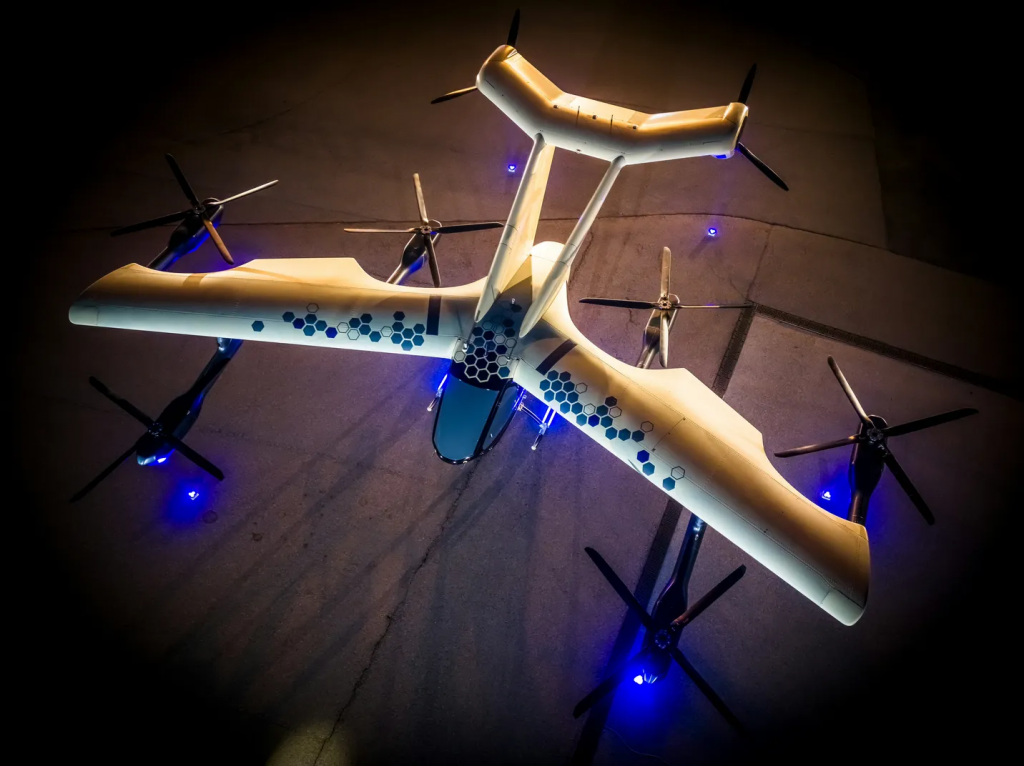Description

Source: DownToEarth
Disclaimer: Copyright infringement not intended.
Context
- eVTOL (Electric Vertical Takeoff and Landing) aircraft have the potential to revolutionize urban transportation, emergency services, and short-haul travel.
- However, like any emerging technology, its impact can be both positive and negative, depending on how it is implemented and utilized.
Details
About eVTOL (Electric Vertical Takeoff and Landing) Aircraft
- eVTOL (Electric Vertical Takeoff and Landing) aircraft represent a transformative development in aviation technology, offering the potential for quiet, efficient, and sustainable air transportation.
- These aircraft are designed to take off, hover, and land vertically using electric power, which makes them well-suited for urban air mobility and short-haul flights.
Key Components of eVTOL Aircraft
- Electric Propulsion System: eVTOLs utilize electric motors powered by batteries or other electric energy sources. This system is crucial for vertical takeoff, hovering, and horizontal flight.
- Batteries: High-energy-density batteries are essential for storing the electric power needed for flight. Advances in battery technology directly impact the range and performance of eVTOL aircraft.
- Flight Control Systems: Advanced avionics and flight control systems are necessary for the precise control required for vertical takeoff and landing, as well as for navigating urban environments.
- Airframe Design: Lightweight and aerodynamic airframes improve efficiency and performance. Materials such as carbon fiber composites are commonly used.
- Rotor and Wing Configuration: eVTOLs can have various rotor and wing configurations, including multicopters (multiple rotors), tiltrotors, and fixed-wing designs with vertical lift capabilities.
Types of eVTOL Aircraft
- Multicopters: Resembling drones, these have multiple rotors (typically four or more) and are simple in design, suitable for short-range flights.
- Tiltrotors: Equipped with rotors that tilt to provide both vertical lift and forward thrust, combining the benefits of helicopters and fixed-wing aircraft.
- Lift + Cruise: These have separate systems for vertical lift (rotors) and horizontal flight (fixed wings), optimizing performance for each phase of flight.
- Vectored Thrust: These use adjustable thrust vectors to control flight dynamics, allowing for versatile maneuvering.
Applications of eVTOL Aircraft
- Urban Air Mobility (UAM): Providing quick and efficient transportation within cities, reducing traffic congestion and travel time.
- Emergency Services: Offering rapid response capabilities for medical emergencies, search and rescue operations, and disaster relief.
- Regional Air Transport: Connecting regional hubs with efficient, short-haul flights, complementing existing transportation networks.
- Cargo Transport: Delivering goods and packages in urban and remote areas with speed and efficiency.

Potential Benefits of eVTOL
- Low Maintenance and Operating Costs: eVTOL aircraft use electric propulsion systems, which are simpler and have fewer moving parts compared to traditional internal combustion engines. This leads to lower maintenance requirements and operating costs.
- Environmental Impact: eVTOLs produce zero emissions during flight, contributing to reduced air pollution and greenhouse gas emissions. This makes them an environmentally friendly alternative to traditional aircraft and helicopters.
- Efficiency in Urban Mobility: eVTOLs can take off, hover, and land vertically, allowing them to operate from small urban spaces like rooftops and open grounds. This capability can alleviate road congestion by providing an alternative mode of transportation for daily commutes.
- Emergency Situations: The rapid response capability of eVTOLs makes them ideal for emergency medical services, search and rescue operations, and disaster relief. They can quickly transport patients, medical supplies, and first responders to and from difficult-to-reach locations.
- Economic Opportunities: The development and deployment of eVTOL technology can create new industries and job opportunities in manufacturing, maintenance, air traffic management, and urban infrastructure development.
Challenges and Concerns of eVTOL
- Infrastructure Requirements: The widespread adoption of eVTOLs requires significant investment in infrastructure, such as vertiports (dedicated landing and takeoff areas), charging stations, and air traffic control systems tailored for low-altitude flight.
- Regulatory Framework: Establishing a robust regulatory framework for eVTOL operations is critical. This includes safety standards, air traffic regulations, certification processes, and noise control measures. Coordination between aviation authorities and urban planners is essential.
- Safety Concerns: Ensuring the safety and reliability of eVTOLs is paramount. This involves rigorous testing, certification, and continuous monitoring to prevent accidents and malfunctions. Public confidence in the safety of these aircraft is crucial for their acceptance.
- Urban Integration: Integrating eVTOLs into existing urban environments poses challenges in terms of noise pollution, visual impact, and potential disruptions to daily life. Careful planning and community engagement are necessary to mitigate these issues.
- Cost and Accessibility: While eVTOLs may initially be positioned as premium services, efforts should be made to make them affordable and accessible to a broader population. Addressing economic disparities and ensuring equitable access is important for their success.
Global Developments
- Lilium Jet: The German company Lilium has begun producing battery packs for its Lilium Jet and aims to achieve certification from the European Union Aviation Safety Agency (EASA) by 2026. The aircraft is designed for urban air mobility and regional air transport.
- ePlane Company: An Indian startup incubated at the Indian Institute of Technology, Madras, is expected to launch e-flying taxis in Bengaluru, pending approval from the Directorate General of Civil Aviation.
- CityAirbus NextGen: Airbus is developing the CityAirbus NextGen, which is scheduled for its maiden flight in 2024. The aircraft has an operational range of 80 km and a cruise speed of 120 km/h, designed for quiet urban operations.
Sources:
DownToEarth
|
PRACTICE QUESTION
Q. eVTOLs can offer significant benefits in terms of efficiency, environmental sustainability, and emergency response capabilities. However, addressing the associated challenge is crucial to ensuring that eVTOLs become a boon rather than a bane. Discuss. (250 Words)
|








